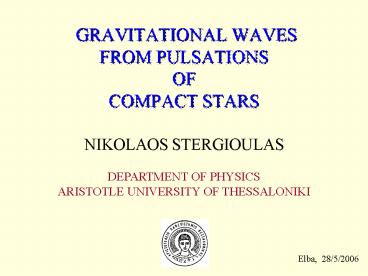GRAVITATIONAL WAVES FROM PULSATIONS OF COMPACT STARS - PowerPoint PPT Presentation
1 / 17
Title:
GRAVITATIONAL WAVES FROM PULSATIONS OF COMPACT STARS
Description:
Stergioulas N., 'Rotating Stars in Relativity', Living Reviews in Relativity, 6, ... In 2D Newtonian simulations a late-time (t 400ms) excitation of g-modes in ... – PowerPoint PPT presentation
Number of Views:20
Avg rating:3.0/5.0
Title: GRAVITATIONAL WAVES FROM PULSATIONS OF COMPACT STARS
1
GRAVITATIONAL WAVES FROM PULSATIONSOFCOMPACT
STARS
NIKOLAOS STERGIOULAS
DEPARTMENT OF PHYSICSARISTOTLE UNIVERSITY OF
THESSALONIKI
Elba, 28/5/2006
2
Plan of Talk
- Core-bounce oscillations during neutron star
formation - Fall-back accretion
- Phase-transition-induced mini-collapse
- Resonant tidal excitation in binary systems
- Gravitational-wave-driven instabilities
3
1. Core-Bounce Oscillations
Dimmelmeier, Font Mueller 2002
GW emission mainly axisymmetric l2 f-modes and
w-modes
Energy 10-8 10-6 Msun gt only rapidly rotating
cores produce strong GWs.
To extract information about Mass, EOS etc. need
to develop
GW-Asteroseismology for rotating neutron stars
4
Numerical Codes
Instead of using perturbative methods, one can
study pulsations using fully nonlinear numerical
codes
Initial Data imported RNS models (N.S., Friedman
1995).
(N. S. Font 2001)
5
New Fourier Technique
Eigenfunctions are extracted by FFT at all points
magnitude of FFT correlates with shape of
eigenfunction
F-mode along x-axis for different rotation rates
6
Andersson Kokkotas (1996)Kokkotas, Apostolatos
Andersson (2001)Benhar, Ferrari Gualtieri
(2004)
Empirical formulas must be extended to rotating
models!
7
Axisymmetric Modes in CFC Approximation
Spacetime evolution with Spatially Conformally
Flat Condition (CFC/IWM)
Dimmelmeier, NS Font (2006)
8
Nonlinear Mode Couplings
Nonlinear harmonics are also excited linear sums
and differences of linear mode frequencies.
Dimmelmeier, NS, Font (2005)
9
Mass-Shedding-Induced Damping
Near mass-shedding limit, fluid elements near
surface are weakly bound (effective gravity
vanishes).
Radial component of pulsations causes
mass-shedding in form of shocks.
This could enhance strong damping in
core-collapse oscillations and enforce nonlinear
saturation for unstable modes.
NS, Apostolatos Font (2004)
10
2. Fall-Back Accretion
If the progenitor star is sufficiently massive,
then significant fall-back accretion will take
place.
Depending on the nonradial structure of the
fall-back material, various pulsation modes can
be excited. A quadrupole shell of 0.01M produces
similar GW amplitude as the core bounce signal
(Nagar et al. 2004).
11
4. Resonant Tidal Excitation in Binary Systems
Typical energy release 1051 ergs.
Signal strength 10-22 at 10Mpc.
Delayed detection would indicate occurrence of
phase transition.
If there is spin-orbit misalignment, the resonant
excitation of an odd-parity m1 inertial mode
can produce a significant phase shift (Lai Wu,
2006).
Such phase shifts need to be accurately modeled
in the data analysis. There is a needfor
computing accurate inertial mode eigenfunctions
for relativistic stars (see e.g. Boutloukos and
Nollert 2006).
12
4. Gravitational-Wave-Driven Instabilities
F-Mode Instability (I)
( N. S. Friedman 1998)
Onset of lm2 instability for
( Morsink, N. S. Friedman 1998)
(Newtonian)
(Full GR)
13
F-Mode Instability (II)
The nonlinear f-mode modifies the background
equilibrium star, inducing differential rotation.
The modified background, in turn, modifies the
f-mode, until saturation is reached.
A uniformly rotating Maclaurin spheroid is driven
along a sequence of Riemann-S ellipsoids towards
a stationary Dedekind ellipsoid.
Gravitational waves are strongest during the
Riemann-S ellipsoid phase.
Lai Shapiro, 1995
14
F-Mode Instability (III)
Lai Shapiro, 1995
In the best-case scenario, the GWs are easily
detectable out to 140 Mpc !
15
Nonlinear Simulation F-Mode Instability
Shibata Karino, 2004
Newtonian accelerated g-r-r N1
polytrope Differentially rotating T/W0.27 -gt
star becomes like Riemann-S ellipsoid
Agrees with basic conclusions of Lai
Shapiro. Major uncertaintyNonlinear
saturation.
16
Saturation of Nonlinear R-Modes
Long-term nonlinear evolution of r-modes using
two different methods
Morsink (2002)Schenk, Arras, Flanagan,
Teukolsky, Wasserman (2002)Arras, Flanagan,
Morsink, Schenk, Teukolsky, Wasserman
(2003)Brink, Teukolsky, Wasserman (2004a, 2004b)
Gressman, Lin, Suen, N. S. Friedman (2002)
When scaled to same resolution, both methods
agree that saturation amplitude is small, of
O(10-3).
17
R-Mode Instability in LMXBs
Andersson, Kokkotas, N.S., 1999
Even with a small saturation amplitude, the
r-mode instability can operate in
LMXBs,balancing the accretion torque.
The signal is nearly monochromatic and if
persistent, it could be detected with a few weeks
of signal integration for galactic sources.
To reduce computational costs in the search,
accurate r-mode frequencies are needed(work in
progress).































